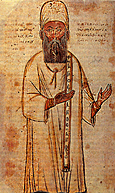 |
|
 |
George Pachymeres
 eorge Pachymeres moved from Nicaea, where he was born, to Constantinople, sometime after 1261. It was there that he first became known for his superior classical scholarship thanks to which he was appointed to the high public offices of
protekdikos
eorge Pachymeres moved from Nicaea, where he was born, to Constantinople, sometime after 1261. It was there that he first became known for his superior classical scholarship thanks to which he was appointed to the high public offices of
protekdikos
 and
dikaiophylax.
He also attained the first rank in the ecclesiastical hierarchy, that of deacon, and became involved in the ecclesiastical
life of his time, voicing his objection to the Union of the Churches. Finally, from 1275 on, he taught at the Patriarchal School of Constantinople the hermeneutics of the New Testament and of the Patristic texts, Aristotelian philosophy, as well as subjects from the Tetractys. His writings are representative of the high level of assimilation of the classical models that was a characteristic of his time. His most important work was the historical Chronike Syngraphe, where his main concern was, as he said, to reveal the truth. As a teacher and philosopher he also wrote rhetorical work, epistles, and the Syntagma ton tessaron mathematon ("Collection of the four lessons"), in order to assist the students of the Tetractys,as well as the Schediasma peri tes philosophias tou Aristotelous ("Notes on the philosophy of Aristotle"), a commentary on
almost all of the writings of Aristotle, a work which is also known as
the "Philosophy of Pachymeres".
and
dikaiophylax.
He also attained the first rank in the ecclesiastical hierarchy, that of deacon, and became involved in the ecclesiastical
life of his time, voicing his objection to the Union of the Churches. Finally, from 1275 on, he taught at the Patriarchal School of Constantinople the hermeneutics of the New Testament and of the Patristic texts, Aristotelian philosophy, as well as subjects from the Tetractys. His writings are representative of the high level of assimilation of the classical models that was a characteristic of his time. His most important work was the historical Chronike Syngraphe, where his main concern was, as he said, to reveal the truth. As a teacher and philosopher he also wrote rhetorical work, epistles, and the Syntagma ton tessaron mathematon ("Collection of the four lessons"), in order to assist the students of the Tetractys,as well as the Schediasma peri tes philosophias tou Aristotelous ("Notes on the philosophy of Aristotle"), a commentary on
almost all of the writings of Aristotle, a work which is also known as
the "Philosophy of Pachymeres".
See also: Hesychasm
Union of the Churches
|